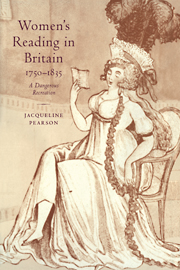Book contents
- Frontmatter
- Contents
- Preface
- Introduction
- 1 Pygmalionesses and the pencil under the petticoat: Richardson, Johnson and Byron
- 2 What should girls and women read?
- 3 The pleasures and perils of reading
- 4 Pleasures and perils of reading: some case histories
- 5 Where and how should women read?
- 6 Preparing for equality: class, gender, reading
- 7 A dangerous recreation: women and novel-reading
- Conclusion
- Notes
- Select bibliography
- Index
1 - Pygmalionesses and the pencil under the petticoat: Richardson, Johnson and Byron
Published online by Cambridge University Press: 22 October 2009
- Frontmatter
- Contents
- Preface
- Introduction
- 1 Pygmalionesses and the pencil under the petticoat: Richardson, Johnson and Byron
- 2 What should girls and women read?
- 3 The pleasures and perils of reading
- 4 Pleasures and perils of reading: some case histories
- 5 Where and how should women read?
- 6 Preparing for equality: class, gender, reading
- 7 A dangerous recreation: women and novel-reading
- Conclusion
- Notes
- Select bibliography
- Index
Summary
A founding text of modern feminist literary theory, Sandra Gilbert and Susan Gubar's The Madwoman in the Attic, centres on the ‘anxiety of influence’ suffered by women writers in a cultural world dominated by men. But how did eighteenth- and nineteenth-century male writers respond to the growing visibility of women writers and commercial importance of women readers, and how were the canonical male writers read by these women?
One of the most striking phenomena of the eighteenth century is the growth of women's involvement in literary culture as writers and as readers, though major changes took place in the nature of this female readership and its reading practices in the course of the period. As early as the 1750s female readership was becoming ‘increasingly decorous’, and by the early nineteenth century Byron noted a growing prudishness in his audience which he bitterly (though not necessarily accurately) blamed on its female members. Mrs Keith of Ravelstone remembered, as a girl in London perhaps in the 1760s, hearing Aphra Behn's fiction ‘read aloud for the amusement of large circles of the first and most creditable in society’: in old age she tried to reread it but, affected by the changing cultural climate, found it too embarrassing to continue. Not only sexual explicitness became problematic for women readers: Mary Russell Mitford complains of ‘want of elegance’ even in the novels of Jane Austen. Texts historically thought appropriate for women were reevaluated because of changing standards of propriety.
- Type
- Chapter
- Information
- Women's Reading in Britain, 1750–1835A Dangerous Recreation, pp. 22 - 41Publisher: Cambridge University PressPrint publication year: 1999



